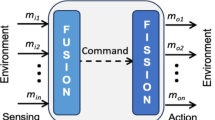Abstract
To calibrate oculokinetic perimetry (OKP) as developed by Damato in terms of conventional perimetric threshold values, 33 eyes with either glaucoma or ocular hypertension were tested with a standard Humphrey Field Analyzer using the Central 30-2 test and twice with a 26-point OKP chart. The frequency of seeing of the OKP test spot was plotted against 30-2 thresholds. This showed a weak relation between the two tests. Subsequently eyes that were considered to have had poor fixation were omitted, but false positive and false negative results still occurred in 19 remaining eyes. To check whether Troxler's effect (local adaptation) might have caused false positives, 6 subjects were tested with OKP, controlling the fixation times. Increasing the fixation time from ‘very short’ to 2 and 5 seconds yielded more ‘not seen’ responses in OKP. False negative data were found to occur preferentially in border areas of visual field defects. The average frequency of seeing curve over all data showed a 50% frequency of seeing for the OKP stimulus at a 14.6 dB equivalent conventional threshold value. The spreading of the curve was 7 dB (95% confidence interval 28 dB).
Similar content being viewed by others
References
Damato BE. Oculokinetic perimetry: a simple visual field test for use in the community. Br J Ophthalmol 1985; 69: 927–31.
Damato BE, Ahmed J, Allan D, McClure E, Jay JL. The detection of glaucomatous visual field defects by oculo-kinetic perimetry: Which points are best for screening? Eye 1989; 3: 727–31.
Alvarez E, Damato BE, Jay JL, McClure E. Comparative evaluation of oculokinetic perimetry and conventional perimetry in glaucoma. Br J Ophthalmol 1988; 72: 258–62.
Alvarez E, Damato B, Wakakura M, McFadzean RM. Oculo-kinetic perimetry. A visual field test for neuro-ophthalmic patients. Neuro-ophthalmology 1988; 8: 23–30.
Clark BJ, Timms C, Franks WA. Oculokinetic perimetry for the assessment of visual fields. Arch Dis Child 1990; 65: 432–4.
Moreland JD. Peripheral colour vision. In: Jameson D, Hurvich LM, (eds) Handbook of sensory physiology, volume VII/4. Visual Psychophysics. New York: Springer-Verlag, 1972: 517–36.
Author information
Authors and Affiliations
Rights and permissions
About this article
Cite this article
Felius, J., Langerhorst, C.T., van den Berg, T.J.T.P. et al. Oculokinetic perimetry compared with standard perimetric threshold testing. Int Ophthalmol 16, 221–226 (1992). https://doi.org/10.1007/BF00917965
Issue Date:
DOI: https://doi.org/10.1007/BF00917965




